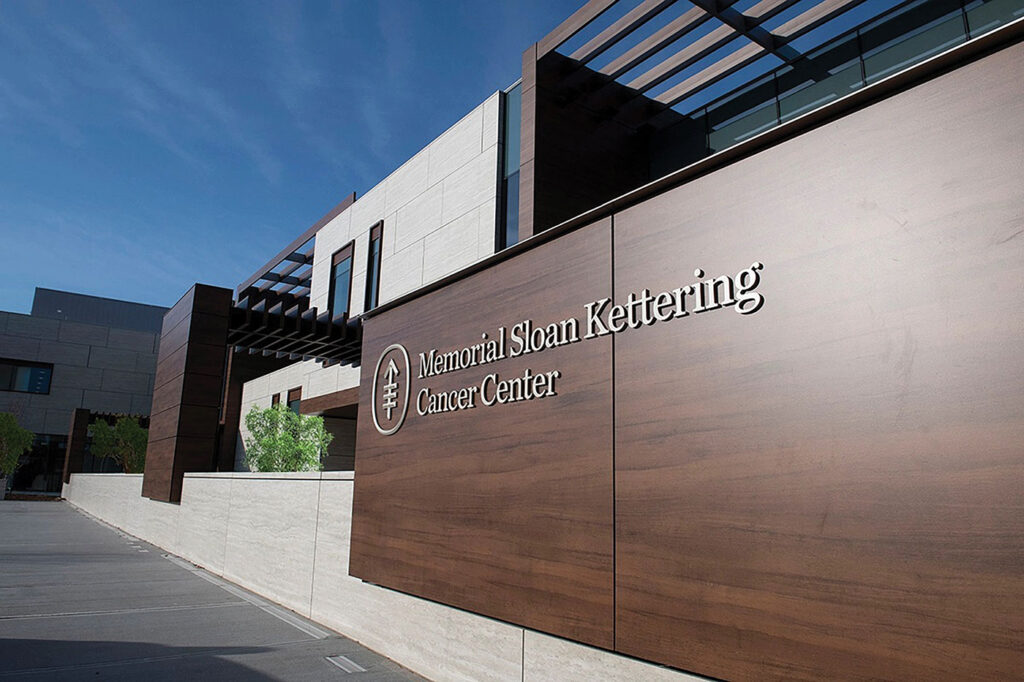
Although incremental innovations in technology and our understanding of cancer biology have led us into a Golden Age, it is only in the last couple of decades, with the emergence and convergence of several technologies, that we can fully reap the rewards of those innovations. And this wealth of understanding only looks to deepen as new insights and innovations come together to enhance cancer prevention, diagnosis, and treatment.
These advances are exemplified by work done in the lab of Scott Lowe, chair of the cancer biology and genetics program at Memorial Sloan Kettering Cancer Center (MSKCC) and an investigator at the Howard Hughes Medical Institute. Lowe and his colleagues have spent decades studying cancer biology and developing new techniques or combining methods to fully understand the molecular mechanisms of tumor formation, evolution, and treatment.
“I absolutely think we’re in the Golden Age of cancer research,” Lowe says. “I think of modern-day cancer research starting in the mid-1980s when it was discovered that gene mutations caused cancer. By understanding what these genes did and how they contributed to cancer, we could ultimately develop therapies to target these mechanisms rationally.”
The treatment of cancer was not always so considered, however.

Improving treatment response
Until recently, cancer was largely treated on the basis of the organ type in which the tumor resided (e.g., breast, lung, colon, etc.), and the cytotoxic drugs used had been identified empirically, having been tested for an effect on cancerous tissues. The microtubule inhibitor docetaxel, for example, used alone or in combination with other treatments, has been approved in the United States to treat prostate, lung, breast, gastric, and head & neck cancers.1 It is also, however, presently in clinical trials for the treatment of urothelial, ovarian, skin, esophageal, nasopharyngeal, and pancreatic cancers, as well as others.2
Although the molecular mechanisms of action for these drugs have been studied, those mechanisms were less relevant to the treatment decisions than was past clinical experience with the drug, and it was difficult to know in advance how or if any given patient would respond to treatment. Despite having what was considered the same cancer, treatment response could vary widely within patient populations. This awareness prompted researchers to look for common features within responder and non-responder populations. Patient genetics seemed to be key.

chair of the cancer biology and genetics program at MSKCC
“We’ve known for a long time that cancer is a genetic disease,” says Lowe. “It occurs when mutations in specific genes cause them to act abnormally, enabling the cell to divide out of control. We often call these mutant genes cancer drivers.”
Also, molecular profiling of patient tumors has shown that each patient’s cancer harbors a distinct set of mutated genes and that the driver mutations can be independent of the organ in which the cancers evolved. This understanding opened the door to treating patients with drugs that specifically target the actions of these mutated genes and thereby improve patient outcomes.
This precision oncology approach transformed cancer from a tissue-specific pathology to a mutation-driven disorder.
“The typical way in which precision oncology is carried out these days is: the patient gets a biopsy; the biopsy gets sequenced for its DNA to find which drivers are present, and then if there’s a drug to match that driver, the patient will be given that therapy,” explains Lowe. “This has proven extraordinarily effective and is almost a mainstay of cancer therapy today.”
Empowering technologies
To fully leverage precision oncology, researchers at organizations like MSKCC have developed and improved a variety of technologies. High-throughput sequencing, for example, has not only allowed researchers to identify driver mutations but is increasingly helping them explore the state of gene expression and predict what proteins will be expressed in what cells, as well as where and when. Combined with genetics, these genomics technologies have expanded our understanding of factors impacting a cell’s state (e.g., proliferative vs. quiescent) and biology.
Another transformative technology, according to Lowe, is CRISPR gene editing.3,4 He draws the analogy of learning how a car works by taking it apart.
“If you see a wire, you might pull it out,” he explains. “If the vehicle no longer starts, you conclude that it is essential for the vehicle to start. If you put the wire back and the car starts, you prove that that was the case.”
“Geneticists do this with genes,” Lowe continues. “We can disrupt a gene in a cell grown in a petri dish and ask if the cells can grow and divide or test some other feature known to be important in cancer cells. CRISPR technology allows us to do that at a much more high-throughput scale than we could even five years ago.”
Information about what genes are drivers of cancer development and how they work can then be fed back into the drug development process to identify biologic or small-molecule interventions that disrupt or rescue these functions, as appropriate, to kill cancer cells or convert them to a non-cancerous state.
However, understanding driver mutations is only one part of developing effective treatments, as few tumors carry a homogeneous population of cancer cells. Instead, cancers evolve over time. Likewise, healthy cells around the cancerous tissue within the tumor microenvironment (TME) may also impact how the cancer evolves and whether it is accessible and sensitive to immune clearance. Thus, to truly understand a tumor it may be necessary to study tissues at the single-cell level.6-8
Within individual cells, researchers can visualize not only what gene mutations drive cancerous cells but also how and where genes are expressed and proteins function within a cell with increasing resolution. Enhancements in technologies such as mass spectrometry, fluorescence microscopy, and sequencing are allowing researchers better access to the sometimes-subtle signals indicating the transition of a cell from pre-malignant to malignant state,6 epigenetic reprogramming,7 or the evolution of treatment resistance.8
Quieting proliferation
Given that a hallmark of cancer is cell cycle dysregulation leading to aberrant proliferation, one area of research that is seeing increased interest in oncology is cellular senescence, a natural mechanism by which the cell cycle is shut down and cells stop dividing.9
“Since cancer cells grow and divide indefinitely, it is intriguing to understand how therapies that promote senescence might be used to prevent or treat cancer,” Lowe says. “A fascinating advance came from the realization that, in some settings, the induction of senescence in cancer cells prevents the cancer cell from dividing and can provoke the recognition of the cancer cell by the immune system.”
He suggests that coaxing the immune system to get rid of cancer and coaxing our body to reject cancer is an inspiring therapeutic approach, and it has been the core tenet of immunotherapy. This field has grown dramatically over the past decade or so.
“However, it doesn’t work for everybody,” Lowe continues. “We think that cancer drugs that induce senescence might be one way to get cancer cells to be better recognized by the immune system.”
Research in his lab has shown several ways in which this is true, increasing tumor sensitivity to interferon expressed by the TME,10 sensitizing tumors to immune checkpoint inhibitors, and increasing immune infiltration of tumors, making cold tumors hot.11,12
Each of these areas has been vital to improvements in oncology, but the synergies between them have completely transformed the field and show little sign of stopping.
“Combining our biological understanding and new technologies, mostly centered around genetics, has revolutionized cancer therapy,” Lowe states. “The data we produce through characterizing a patient’s tumors also gives us new insights into what might cause cancer, how cancers evolve, why they spread to different organs, and so on.”
“This sets up an accelerating discovery loop: new therapies, increased understanding, and more breakthroughs,” he continues. “We are just seeing the tip of the iceberg of this research, which will lead to other novel approaches to detecting and treating cancer over the next decade.”
References
- Taxotere Prescribing Information, Sanofi, US, 2021.
- clinicaltrials.gov/ct2/results?cond=&term=docetaxel (Accessed March 5, 2023)
- Álvarez-Fernández, M., Sanz-Flores, M., Sanz-Castillo, B, et al. Therapeutic relevance of the PP2A-B55 inhibitory kinase MASTL/Greatwall in breast cancer. Cell Death Differ 25(5):828-840 (2018).
- Chen, C.-C., Li, B., Millman, S. E., et al. Vitamin B6 addiction in acute myeloid leukemia. Cancer Cell 37(1):71-84 (2020)
- Zhang, Z., Zhou, C., Li, X., et al. Loss of CHD1 promotes heterogeneous mechanisms of resistance to AR-targeted therapy via chromatin dysregulation. Cancer Cell 37(4):584-598 (2020).
- Baslan, T., Morris IV, J. P., Zhao, Z., et al. Ordered and deterministic cancer genome evolution after p53 loss. Nature 608(7924):795-802 (2022)
- Alonso-Curbelo, D., Ho, Y.-J., Burdziak, C., et al. A gene-environment induced epigenetic program initiates tumorigenesis. Nature 590(7847):642-648 (2021)
- Xue, Y., Martelotto, L., Baslan, T., et al. An approach to suppress the evolution of resistance in BRAFV600E-mutant cancer. Nature Medicine 23(8):929-937 (2017).
- Prasanna, P. G., Citrin, D. E., Hildesheim, J., et al. Therapy-induced senescence: Opportunities to improve anticancer therapy. JNCI 113(10):1285-1298 (2021).
- Chen, H.-A., Ho, Y.-J., Mezzadra, R., et al. Senescence rewires microenvironment sensing to facilitate anti-tumor immunity. Cancer Discovery 13(2):432-453 (2023).
- Ruscetti, M., Morris IV, J. P., Mezzadra, R., et al. Senescence-induced vascular remodeling creates therapeutic vulnerabilities in pancreas cancer. Cell 181:424-441 (2020).
- Paffenholz, S. V., Salvagno, C., Ho, Y.-J., et al. Senescence induction dictates response to chemo- and immunotherapy in preclinical models of ovarian cancer. PNAS 119(5):e2117754119 (2022).
Damian Doherty has been in media and publishing for nearly 30 years, beginning in the early nineties at News Corporation. Damian has managed, edited, and launched life science titles in drug discovery and precision medicine. He was features editor of Drug Discovery World for fourteen years and founded, established, and edited the Journal of Precision Medicine in 2014. In parallel, Damian founded and organized the Precision Medicine Leaders’ Summit, a global, immersive 3-day senior leadership conference that still runs today. He edited AIMed magazine in 2019 before launching Photo51Media, a platform for illuminating untold, compelling stories in precision healthcare. Damian joined Mary Ann Liebert in 2021 to help steer the new rebrand and relaunch of Clinical OMICS to Inside Precision Medicine.













